Configuring a CircleCI-based pipeline to build multi-architecture Docker images
multi-architecture docker images dockerContact me for information about consulting and training at your company.
The MEAP for Microservices Patterns 2nd edition is now available
This is the third article about my adventures trying to use my Apple M1 MacBook for development.
In the previous article, I covered how to use the docker build buildx command to create a multi-architecture Docker image.
In this article, I describe how a CircleCI CI/CD pipeline can use docker build buildx to build a multi-architecture image and push it to a remote registry.
The other articles in this series are:
- Part 1 - My Apple M1 MacBook: lots of cores, memory and crashing containers
- Part 2 - Building multi-architecture Docker images for Intel and ARM
- Part 4 - Testing an Intel and Arm multi-architecture Docker image on CircleCI
- Part 5 - Configuring CircleCI to publish a multi-architecture Docker image
- Part 6 - Developing the Eventuate Common library on an M1/Arm MacBook
- Part 7 - Configuring CircleCI to build, test and publish multi-architecture images for Eventuate Common
- Part 8 - Building a multi-architecture Docker image for Apache Kafka
- Part 9 - Publishing multi-architecture base images for services
- Part 10 - Publishing a multi-architecture Docker image for the Eventuate CDC service
- Part 11 - The Eventuate Tram Customers and Orders example now runs on Arm/M1 MacBook!!

Running docker buildx build on CircleCI: first attempt
The microservice-canvas/plantuml has a simple CircleCI pipeline that runs docker build to build the image, tests it locally and then pushes it to Docker Hub.
I thought a good way to start was to add a new step to the job that simply runs the build-and-test-multi-arch-locally.sh, which I described in the previous article:
- run:
name: docker buildx build
command: |
docker buildx create --use
./build-and-test-multi-arch-circleci.sh
- run: ./build-and-test-docker.sh
This step runs prior to original build script with the goal of creating an image in the local registry container. However, when pipeline ran, it failed with a surprising new error:
error: could not create a builder instance with TLS data loaded from environment. Please use `docker context create <context-name>` to create a context for current environment and then create a builder instance with `docker buildx create <context-name>`
The solution was to create Docker context and create a builder that uses that context.
- run:
name: docker buildx build
command: |
docker context create tls-env
docker buildx create tls-env --use
./build-and-test-multi-arch-circleci.sh
- run: ./build-and-test-docker.sh
This time docker buildx build built the image.
But the command then failed to push it to the registry:
=> => pushing layers 0.0s
------
> exporting to image:
------
error: failed to solve: failed to do request: Head "http://host.docker.internal:5002/v2/plantuml/blobs/sha256:69d06718b798aebf8c13b1a53299d1f791f8118dcd0fa9a0a827bf2f595aa9ca": dial tcp: lookup host.docker.internal on 172.28.0.2:53: no such host
The CircleCI remote docker environment doesn’t support the special DNS name host.docker.internal.
But what’s even worse is that the CircleCI remote docker environment does not provide network access between the Docker containers and the host machine.
Its primarily use case is building Docker images and pushing them to remote registries.
Consequently, it’s not clear how to push or pull an image to/from a registry container
Furthermore, even if it could be done, the registry is local to a single CircleCI job.
It can’t be used for a multi-job pipeline tests the image on multiple architectures.
Pushing the multi-architecture image to a remote registry
The solution is to push the newly created image to a remote registry.
But which registry and which repository?
I’d like to only use Docker Hub for released images.
But for reasons that I’ll describe in a later article, the only solution I could find that supports publishing tested image to Docker Hub is to push the new image to microservicesio/plantuml using a test-build-* tag that indicates it’s work-in-progress!
To implement these changes I wrote a build-and-test-multi-arch-circleci.sh that’s similar to build-and-test-multi-arch-locally.sh except that it uses a remote registry:
TARGET_IMAGE=microservicesio/plantuml:test-build-${CIRCLE_SHA1?}
docker login ...
docker buildx create tls-env --use
docker buildx build --platform linux/amd64,linux/arm64 \
-t ${TARGET_IMAGE} --push ...
docker run -i --rm --net=none ${TARGET_IMAGE} ...
When I ran this script, it pushed and then tested the image microservicesio/plantuml:test-build-13559a740bb0eba57bdebe50871b3188ad8ed4a5.
Since this image is in a remote repository, I was also able to run it on my M1 MacBook!
As expected, it ran without any problems.
The docker inspect microservicesio/plantuml:test-build-1355... command showed that image’s architecture was arm64.
In the next article, I’ll describe how to enhance the CircleCI pipeline to test the image on an ARM platform.
To see the changes I made to the project, take a look at this Github commit.


 Premium content now available for paid subscribers at
Premium content now available for paid subscribers at 




